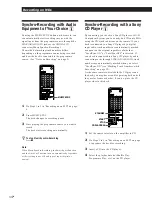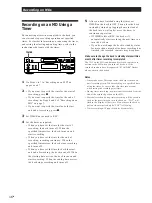
9
EN
Recording on MDs
The MD deck uses the SCMS (Serial Copy Management
System on page 36)
MDs recorded through digital input connector cannot be
copied onto other MDs or DAT tapes through the digital
output connector.
When recording digital signals that have been emphasized
(in the higher frequencies)
The signal is automatically de-emphasized (with attenuation
proportional to the degree of emphasis) and the level of the
de-emphasized signal is indicated on the peak level meters.
When the deck is recording or in recording pause, digital
signals input through DIGITAL IN are output to DIGITAL
OUT with the same sampling rate.
To change the digital input signal to another sampling rate
for output (without recording it to an MD), use Input
Monitor Function (see page 10).
•
•
•
•
•
•
•
•
•
•
•
p
·∏
• •
• •
• • •
r
)
0
§
=
+
DISPLAY/CHAR
Recording on MDs
Useful Tips for Recording
Checking the remaining recordable time on
the MD
• When you press DISPLAY/CHAR while recording,
the remaining recordable time on the MD appears.
• When you press DISPLAY/CHAR repeatedly while
the deck is stopped, the display changes as follows:
total recorded time, remaining recordable time on
the MD, disc name (see page 17).
(Continued)
Notes on Recording
If “Protected” appears in the display
The MD is record-protected. Close the slot to record on the
disc (see “To protect an MD against accidental erasure” on
page 7).
If “Din Unlock” flashes in the display
• The digital programme source is not connected as you set
with INPUT in Step 4 on page 6.
To continue, connect the programme source properly.
• The programme source is not on.
Turn on the programme source.
Depending on source being recorded, track numbers are
marked in following ways:
• When recording from a CD or MD with INPUT at
DIGITAL and the source connected through DIGITAL IN:
The deck automatically marks track numbers in the same
sequence as the original. If, however, a track is repeated
two or more times (e.g. by single-track repeat play) or two
or more tracks with the same track number (e.g. from
different MDs or CDs) are played, the track or tracks are
recorded as part of a single, continuous track with a single
track number.
If the source is an MD, track numbers may not be marked
for tracks of less than 4 seconds.
• When recording with INPUT at DIGITAL the deck may
not automatically mark track numbers for some CD
players and multi disc players. In these cases, mark the
track numbers afterwards using the deck’s Divide
Function (see “Dividing Recorded Tracks” on page 26).
• When recording from source connected through LINE
(ANALOG) IN with INPUT at ANALOG, and “LEVEL-
SYNC” does not light up (see “Marking Track Numbers
while Recording” on page 12) or when recording from
DAT or satellite broadcasts connected through DIGITAL
IN with INPUT at DIGITAL:
The source will be recorded as a single track. You can
divide the track afterwards using the Divide Function on
page 26 or mark track numbers during recording by using
the Track Marking Function on page 12.
If “LEVEL-SYNC” appears in the display, the deck
automatically marks track numbers when recording
analog source or digital recording of DAT or satellite
broadcasts (see “Marking track numbers automatically”
on page 12).
• When recording from DAT or satellite broadcasts with
INPUT at DIGITAL, the deck automatically marks a track
number whenever the sampling frequency of the input
signal changes.
When “TOC” flashes in the display
The deck is currently updating the Table Of Contents (TOC).
Do not move the deck or pull out the mains lead. Changes
to an MD made through recording are saved only when you
update the TOC by ejecting the MD or changing the deck to
standby by pressing
1/u
.










































